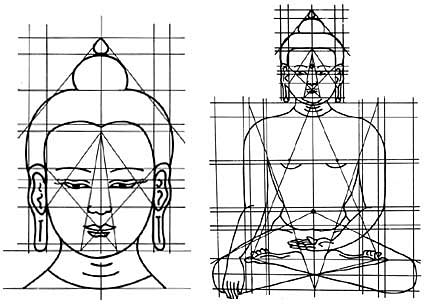Buddhist Art and Architecture : The Buddha Image

The perfect proportions of a Buddha, the graciousness of his physical form, represent one of the ten qualities or powers of a Buddha. They are the characteristics of the physical harmony and beauty of a Great Being, and are described in Story of the Life of Buddha Shakyamuni. There are thirty-two major and eighty minor characteristics. The lines of the eight-spoked on the soles and palms of a Buddha are among them. The appearance and the measurements of a Buddha are perishable and a worldly conception: they describe the ideal picture of a Heavenly Body. They are not subject to change like growth, sickness and death, which can only affect the earthly incarnation of a Buddha.
Examining the canon of the body of a Buddha, one realises that every detail represents harmonious proportions. Everything, the spot between the eyebrows, marking the eye of wisdom, as well as the tip of the nose, has its own special place. The nose has its specific length, just as the ears have their own characteristically exaggerated length. The symbol of a Buddha’s greatest enlightenment is the so-called enlightenment-elevation on the top of the head, described in old texts as that which emerges out of the head of an enlightened saint. It is the visible symbol of the spiritual generative power that strives towards heaven and passes into the immaterial sphere.
The ideal proportions of any image of the Buddha are described in books on iconography. The canonic prototype shows the seated Buddha with his legs crossed and the soles of his feet visible. This yoga-posture has a pre-Buddhist tradition in India, appearing for the first time on the seals of Mohenjodaro in the third millennium BC. This yoga-posture hides the lower part of the body. The broad shoulders are emphasised in early Buddhist sculptures of Mathura. These characteristics, and the slightly almond eye of Buddha Sakyamuni, hint at his descent from the Licchavi clan, related to the Proto-Tibetans by kinship and blood. Before the final domination of the Indo-Europeans, these Licchavis ruled in northern India and the Himalayan regions. Their principalities had democratic constitutions with equal rights and no discrimination of sex or race. Buddhism and its founder must be considered on the basis of this social structure which is confirmed in the oldest texts as well as in the modern Oxford History of India.
Physical Marks
Ushnisha, the Enlightenment Elevation above the fontanelle; is the flame-topped elevation on the head of the Buddha, defined as that which emerges from the head of a Fully Enlightened One.
Urna, the mark in the centre of the forehead, called the Eye of Wisdom, also depicted as a Bundle of Rays or fine hairs between the eyebrows.
The lower part of the body is covered by the Diamond-Seat (Vajrasana). This is the meditation pose (Dhayanasana) of utmost concentration with the legs crossed so that the soles are visible.
The Subtle Energy-Spheres of the Body
The Enlightenment-Centre, the Top of the Head or fontanelle above the upper cerebrum, called Sphere of the Thousand-petalled Lotus(SAHASHRARA-CAKRA).
The cerebral centre of thinking and conscious-power, called Command-Centre (AJNA-CAKRA), the forehead between the eyebrows; ascribed to lotus-centre.
The guttural centre or subtle Sphere of Speech (VISHUDDHA-CAKRA) at the base of the throat.
The cardiac plexus, the emotional Sphere of the Inner Voice (ANAHATA-CAKRA), called the Source of the Heart, situated in the central region of the thorax or chest.
The solar plexus with the gastric plexus, called `the brain of the belly’, Fiery-lustrous or Navel-Centre (MANIPURA- CAKRA) in the region of the loins and connected with the lumbar plexus.
The sacral plexus, called Root-Centre (MULADHARA-CAKRA) or Secret Place, being the root of all streams of vital energy (NADIS) in the region of the rump-bone or sacrum.
The human body is the receptacle of the power of thinking described as a bundle of energy and pervaded by the so-called breath of life flowing in subtle streams throughout the body.

